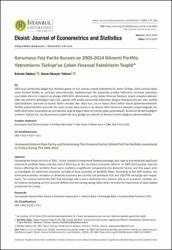Korumasız faiz parite kuramı ve 2005-2014 dönemi portföy yatırımlarını Türkiye’ye çeken finansal faktörlerin tespiti

View/
Access
info:eu-repo/semantics/openAccesshttp://creativecommons.org/licenses/by-nc/3.0/us/Date
2019Metadata
Show full item recordAbstract
2001 krizi sonrasında dalgalı kur rejimine geçen ve kriz sonrası yapısal reformlara hız veren Türkiye, 2014 sonuna kadar
artan küresel likidite ve sermaye yatırımlarından faydalanmıştır. Bu çalışmada yurtdışı faktörlerin sermaye yatırımları
üzerindeki etkisinin nispeten az olduğu 2005-2014 döneminde, yurtiçi baskın finansal faktörün tespiti amaçlanmaktadır.
Ülke risk priminin göstergesi olan CDS, yapılan VAR analizi sonucunda ödemeler dengesi bilançosunda yer alan portföy
yükümlülükleri üzerinde en baskın faktör olmakta iken döviz kuru ise en baskın ikinci faktör olarak gözlemlenmektedir.
Portföy yükümlülükleri üzerinde faiz oranı yerine döviz kurunun bu derece etkili olmasının sebepleri araştırıldığında ise;
2005-2014 yılları arasında artan cari işlemler açığı ve düşen tasarruf oranları göze çarpmaktadır. Bu durum da katma değerli
üretimin Türkiye için, dış finansmana erişiminde zora girdiği son yıllarda ne derece önemli olduğunu göstermektedir. Following the financial crisis of 2001, Turkey started to implement floating exchange rate regime and attracted significant
amount of portfolio flows until the end of 2014 due to the structural economic reforms. In 2005-2014 period, external
factors affecting the portfolio flows were relatively insignificant compared to the domestic factors and this paper aims
to investigate the dominant economic variable of local economy on portfolio flows. According to the VAR analysis, the
dominant economic variables on domestic economy are country risk premium-CDS and USD/TRY exchange rate respectively. The reasons behind the fact that exchange rate is more dominant than interest rate as an economic variable, can
be listed as increasing current account deficits and decreasing saving ratios which stresses the importance of value-added
production for Turkey.
Source
Ekoist: Journal of Econometrics and StatisticsVolume
14Issue
29Collections
The following license files are associated with this item:


















